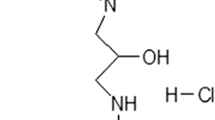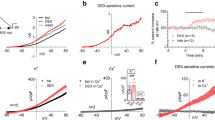Abstract
In this study, we investigated the effects of biapigenin, a biflavone present in the extracts of Hypericum perforatum, in rat brain mitochondrial bioenergetics and calcium homeostasis. We found that biapigenin significantly decreased adenosine diphosphate (ADP)-induced membrane depolarization and increased repolarization (by 68 and 37%, respectively). These effects were blocked by atractyloside and bongkrekic acid, but not oligomycin. In the presence of biapigenin, an ADP-stimulated state 3 respiration was still noticeable, which did not happen in the presence of adenine nucleotide translocator (ANT) inhibitors. Taking in consideration the relevance of the ANT in the modulation of the mitochondrial permeability transition pore (mPTP), mitochondrial calcium homeostasis was evaluated alone or in the presence of biapigenin. We found that biapigenin reduces mitochondrial calcium retention by increasing calcium efflux, an effect that was blocked by ADP plus oligomycin, an efficient blocker of the mPTP in brain mitochondria. Taken together, the results in this article suggest that biapigenin modulates mPTP opening, possibly by modulating ANT function, contributing for enhanced mitochondrial calcium efflux, thereby reducing calcium burden and contributing for neuroprotection against excitotoxicity.









Similar content being viewed by others
Abbreviations
- ΔΨm :
-
Mitochondrial transmembrane electric potential
- ANT:
-
Adenosine nucleotide translocator
- CsA:
-
Cyclosporin A
- FCCP:
-
Carbonyl cyanide 4-(trifluoromethoxy) phenylhydrazone
- mPTP:
-
Mitochondrial permeability transition pore
- TPP:
-
Tetraphenylphosphonium-chloride
References
Andreyev AY, Kushnareva YE, Starkov AA (2005) Mitochondrial metabolism of reactive oxygen species. Biochemistry 70:200–214
Belisle E, Kowaltowski AJ (2002) Opening of mitochondrial K+ channels increases ischemic ATP levels by preventing hydrolysis. J Bioenerg Biomembr 34:285–298
Bravo C, Vargas-Suárez M, Rodríguez-Enríquez S, Lova-Tavera H, Moreno-Sánchez R (2001) Metabolic changes induced by cold stress in rat liver mitochondria. J Bioenerg Biomembr 33:289–301
Brookes PS, Yoon Y, Robotham JL, Anders MW, Sheu SS (2004) Calcium, ATP, and ROS: a mitochondrial love-hate triangle. Am J Physiol Cell Physiol 287:C817–C833
Bruni A, Luciani S, Contessa AR (1964) Inhibition by atractyloside of the binding of adenine-nucleotides to rat-liver mitochondria. Nature 201:1219–1220
Bruni A, Luciani S, Bortignon C (1965) Competitive reversal by adenine nucleotides of atractyloside effect on mitochondrial energy transfer. Biochim Biophys Acta 97:434–441
Brustovetsky N, Dubinsky JM (2000) Dual responses of CNS mitochondria to elevated calcium. J Neurosci 20:103–113
Brustovetsky N, Klingenberg M (1994) The reconstituted ADP/ATP carrier can mediate H+ transport by free fatty acids, which is further stimulated by mersalyl. J Biol Chem 269:27329–27336
Brustovetsky NN, Dedukhova VI, Egorova MV, Mokhova EN, Skulachev VP (1990) Inhibitors of the ATP/ADP antiporter suppress stimulation of mitochondrial respiration and H+ permeability by palmitate and anionic detergents. FEBS Lett 272:187–189
Chen C, Ko Y, Delannoy M, Ludtke SJ, Chiu W, Pedersen PL (2004) Mitochondrial ATP synthasome: three-dimensional structure by electron microscopy of the ATP synthase in complex formation with carriers for Pi and ADP/ATP. J Biol Chem 279:31761–31768
Cho J, Lee HK (2004) Wogonin inhibits excitotoxic and oxidative neuronal damage in primary cultured rat cortical cells. Eur J Pharmacol 485:105–110
Comelli M, Metelli G, Mavelli I (2007) Downmodulation of mitochondrial F0F1 ATP synthase by diazoxide in cardiac myoblasts: a dual effect of the drug. Am J Physiol Heart Circ Physiol 292:H820–H829
Dahout-Gonzalez C, Ramus C, Dassa EP, Dianoux AC, Brandolin G (2005) Conformation-dependent swinging of the matrix loop m2 of the mitochondrial Saccharomyces cerevisiae ADP/ATP carrier. Biochemistry 44:16310–16320
Dahout-Gonzalez C, Nury H, Trezeguet V, Lauquin GJ, Pebay-Peyroula E, Brandolin G (2006) Molecular, functional, and pathological aspects of the mitochondrial ADP/ATP carrier. Physiology 21:242–249
De Paola R, Muia C, Mazzon E, Genovese T, Crisafulli C, Menegazzi M, Caputi AP, Suzuki H, Cuzzocrea S (2005) Effect of Hypericum perforatum extract in a rat model of ischemia and reperfusion injury. Shock 24:255–263
Di Carlo G, Borrelli F, Ernst E, Izzo AA (2001) St John’s wort: Prozac from the plant kingdom. Trends Pharmacol Sci 22:292–297
Dias ACP, Tomas-Barberan FA, Fernandes-Ferreira FA, Ferreres F (1998) Unusual flavonoids produced by callus of Hypericum perforatum. Phytochemistry 48:1165–1168
Dorner A, Olesch M, Giessen S, Pauschinger M, Schultheiss HP (1999) Transcription of the adenine nucleotide translocase isoforms in various types of tissues in the rat. Biochim Biophys Acta 1417:16–24
Dubinsky JM, Brustovetsky N, LaFrance R (2004) Protective roles of CNS mitochondria. J Bioenerg Biomembr 36:299–302
Duchen MR (2004) Mitochondria in health and disease: perspectives on a new mitochondrial biology. Mol Aspects Med 25:365–451
Estabrook RW (1967) Mitochondrial respiratory control and the polarographic measurement of ADP: O ratios. Methods Enzymol 10:41–47
Fernandez-Gomez FJ, Galindo MF, Gomez-Lazaro M, González-Garcia C, Ceña V, Aguirre N, Jordán J (2005) Involvement of mitochondrial potential and calcium buffering capacity in minocycline cytoprotective actions. Neuroscience 133:959–967
Ferreira FM, Madeira VM, Moreno AJ (1997) Interactions of 2, 2-bis(p-chlorophenyl)-1, 1-dichloroethylene with mitochondrial oxidative phosphorylation. Biochem Pharmacol 53:299–308
Halestrap AP (2006) Calcium, mitochondria and reperfusion injury: a pore way to die. Biochem Soc Trans 34:232–237
Halestrap AP, Brenner C (2003) The adenine nucleotide translocase: a central component of the mitochondrial permeability transition pore and key player in cell death. Curr Med Chem 10:1507–1525
Halestrap AP, McStay GP, Clarke SJ (2002) The permeability transition pore complex: another view. Biochimie 84:153–166
Halestrap AP, Clarke SJ, Khaliulin I (2007) The role of mitochondria in protection of the heart by preconditioning. Biochim Biophys Acta 1767:1007–1031
He L, Lemasters JJ (2002) Regulated and unregulated mitochondrial permeability transition pores: a new paradigm of pore structure and function? FEBS Lett 512:1–7
Henderson PJ, Lardy HA (1970) Bongkrekic acid. An inhibitor of the adenine nucleotide translocase of mitochondria. J Biol Chem 245:1319–1326
Ichas F, Mazat JP (1998) From calcium signaling to cell death: two conformations for the mitochondrial permeability transition pore. Switching from low- to high-conductance state. Biochim Biophys Acta 1366:33–50
Ishige K, Schubert D, Sagara Y (2001) Flavonoids protect neuronal cells from oxidative stress by three distinct mechanisms. Free Radic Biol Med 30:433–446
Kamo N, Muratsugu M, Hongoh R, Kobatake Y (1979) Membrane potential of mitochondria measured with an electrode sensitive to tetraphenyl phosphonium and relationship between proton electrochemical potential and phosphorylation potential in steady state. J Membr Biol 49:105–121
Ko YH, Delannoy M, Hullihen J, Chiu W, Pedersen PL (2003) Mitochondrial ATP synthasome. Cristae-enriched membranes and a multiwell detergent screening assay yield dispersed single complexes containing the ATP synthase and carriers for Pi and ADP/ATP. J Biol Chem 278:12305–12309
Kowaltowski AJ, Maciel EN, Fornazari M, Castilho RF (2006) Diazoxide protects against methylmalonate-induced neuronal toxicity. Exp Neurol 201:165–171
Kristal BS, Stavrovskaya IG, Narayanan MV, Krasnikov BF, Brown AM, Beal MF, Friedlander RM (2004) The mitochondrial permeability transition as a target for neuroprotection. J Bioenerg Biomembr 36:309–312
Kroemer G, Galluzzi L, Brenner C (2007) Mitochondrial membrane permeabilization in cell death. Physiol Rev 87:99–163
Kumar V, Mdzinarishvili A, Kiewert C, Abbruscato T, Bickel U, van der Schyf CJ, Klein J (2006) NMDA receptor-antagonistic properties of hyperforin, a constituent of St. John’s Wort. J Pharmacol Sci 102:47–54
Lee H, Bae JH, Lee SR (2004) Protective effect of green tea polyphenol EGCG against neuronal damage and brain edema after unilateral cerebral ischemia in gerbils. J Neurosci Res 77:892–900
Madeira VM, Antunes-Madeira MC, Carvalho AP (1974) Activation energies of the ATPase activity of sarcoplasmic reticulum. Biochem Biophys Res Commun 58:897–904
Mansson R, Hansson MJ, Morota S, Uchino H, Ekdhal CT, Elmér E (2007) Re-evaluation of mitochondrial permeability as a primary neuroprotective target of minocycline. Neurobiol Dis 25:198–205
Montero M, Lobaton CD, Hernandez-Sanmiguel E, Santodomingo J, Vay L, Moreno A, Alvarez J (2004) Direct activation of the mitochondrial calcium uniporter by natural plant flavonoids. Biochem J 384:19–24
Moreira PI, Santos MS, Sena C, Seica R, Oliveira CR (2005) Insulin protects against amyloid beta-peptide toxicity in brain mitochondria of diabetic rats. Neurobiol Dis 18:628–637
Murata M, Akao M, O’Rourke B, Marban E (2001) Mitochondrial ATP-sensitive potassium channels attenuate matrix Ca(2+) overload during simulated ischemia and reperfusion: possible mechanism of cardioprotection. Circ Res 89:891–898
Oliveira PJ, Seica R, Coxito PM, Rolo AP, Palmeira CM, Santos MS, Moreno AJ (2003) Enhanced permeability transition explains the reduced calcium uptake in cardiac mitochondria from streptozotocin-induced diabetic rats. FEBS Lett 554:511–514
Oliveira PJ, Bjork JÁ, Santos MS, Leino RL, Froberg MK, Moreno AJ, Wallace KB (2004) Carvedilol-mediated antioxidant protection against doxorubicin-induced cardiac mitochondrial toxicity. Toxicol Appl Pharmacol 200:159–168
Parihar MS, Brewer GJ (2007) Mitoenergetic failure in Alzheimer disease. Am J Physiol Cell Physiol 292:C8–C23
Park C, So HS, Shin CH, Baek SH, Moon BS, Shin SH, Lee HS, Lee DW, Park R (2003) Quercetin protects the hydrogen peroxide-induced apoptosis via inhibition of mitochondrial dysfunction in H9c2 cardiomyoblast cells. Biochem Pharmacol 66:1287–1295
Pietrobon D, Luvisetto S, Azzone GF (1987) Uncoupling of oxidative phosphorylation. Alternative mechanisms: intrinsic uncoupling or decoupling? Biochemistry 26:7339–7347
Rasola A, Bernardi P (2007) The mitochondrial permeability transition pore and its involvement in cell death and in disease pathogenesis. Apoptosis 12:815–833
Rice-Evans C (2001) Flavonoid antioxidants. Curr Med Chem 8:797–807
Santos AC, Uyemura SA, Lopes JL, Bazon JN, Mingatto FE, Curti C (1998) Effect of naturally occurring flavonoids on lipid peroxidation and membrane permeability transition in mitochondria. Free Radic Biol Med 24:1455–1461
Schroeter H, Williams RJ, Matin R, Iversen L, Rice-Evans CA (2000) Phenolic antioxidants attenuate neuronal cell death following uptake of oxidized low-density lipoprotein. Free Radic Biol Med 29:1222–1233
Shabalina IG, Kramarova TV, Nedergaard J, Cannon B (2006) Carboxyatractyloside effects on brown-fat mitochondria imply that the adenine nucleotide translocator isoforms ANT1 and ANT2 may be responsible for basal and fatty-acid-induced uncoupling respectively. Biochem J 399:405–414
Shin DH, Bae YC, Kim-Han JS, Lee JH, Choi IY, Son KH, Kang SS, Kim WK, Han BH (2006a) Polyphenol amentoflavone affords neuroprotection against neuronal hypoxic-ischemic brain damage via multiple mechanisms. J Neurochem 96:561–572
Shin WH, Park SJ, Kim EJ (2006b) Protective effects of anthocyanins in middle cerebral artery occlusion and reperfusion model of cerebral ischemia in rats. Life Sci 79:286–296
Silva B, Oliveira PJ, Dias ACP, Malva JO (2008) Quercetin, kaempferol and biapigenin from Hypericum perforatum are neuroprotective against excitotoxic insults. Neurotoxicity Res 13:265–279
Stocchi V, Cucchiarini L, Magnani M, Chiarantini L, Palma P, Crescentini G (1985) Simultaneous extraction and reverse-phase high-performance liquid chromatographic determination of adenine and pyridine nucleotides in human red blood cells. Anal Biochem 146:118–124
Stout AK, Raphael HM, Kanterewicz BI, Klann E, Reynolds IJ (1998) Glutamate-induced neuron death requires mitochondrial calcium uptake. Nat Neurosci 1:366–373
Teshima Y, Akao M, Li RA, Chong TH, Baumgartner WA, Johnston MV, Marbán E (2003) Mitochondrial ATP-sensitive potassium channel activation protects cerebellar granule neurons from apoptosis induced by oxidative stress. Stroke 34:1796–1802
Urushitani M, Nakamizo T, Inoue R, Sawada H, Kihara T, Honda K, Akaike A, Shimohama S (2001) N-methyl-D-aspartate receptor-mediated mitochondrial Ca(2+) overload in acute excitotoxic motor neuron death: a mechanism distinct from chronic neurotoxicity after Ca(2+) influx. J Neurosci Res 63:377–387
Vieira HL, Haouzi D, El-Hamel C, Jacotot E, Belzacq AS, Brenner C, Kroemer G (2000) Permeabilization of the mitochondrial inner membrane during apoptosis: impact of the adenine nucleotide translocator. Cell Death Differ 7:1146–1154
Wu L, Shen F, Lin L, Zhang X, Bruce IC, Xia Q (2006) The neuroprotection conferred by activating the mitochondrial ATP-sensitive K+ channel is mediated by inhibiting the mitochondrial permeability transition pore. Neurosci Lett 402:184–189
Yazawa K, Kihara T, Shen H, Shimmyo Y, Niidome T, Sugimoto H (2006) Distinct mechanisms underlie distinct polyphenol-induced neuroprotection. FEBS Lett 580:6623–6628
Zanotti F, Guerrieri F, Capozza G, Fiermonte M, Berden J, Papa S (1992) Role of F0 and F1 subunits in the gating and coupling function of mitochondrial H(+)-ATP synthase. The effect of dithiol reagents. Eur J Biochem 208:9–16
Acknowledgment
We acknowledge the Portuguese Foundation for Science and Technology and FEDER for support, PhD grant SFRH/BD/13488/2003, and research projects POCI/SAU-NEU/58492/2004.
Author information
Authors and Affiliations
Corresponding author
Rights and permissions
About this article
Cite this article
Silva, B.A., Oliveira, P.J., Cristóvão, A. et al. Biapigenin Modulates the Activity of the Adenine Nucleotide Translocator in Isolated Rat Brain Mitochondria. Neurotox Res 17, 75–90 (2010). https://doi.org/10.1007/s12640-009-9082-5
Received:
Revised:
Accepted:
Published:
Issue Date:
DOI: https://doi.org/10.1007/s12640-009-9082-5




